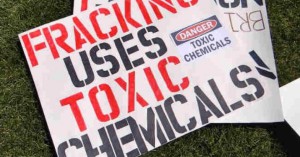 For some time now scientists have been warning about the dangers of fracking and toxic chemicals and how they might include carcinogens and what are known as endocrine disrupting chemicals or EDCs.
For some time now scientists have been warning about the dangers of fracking and toxic chemicals and how they might include carcinogens and what are known as endocrine disrupting chemicals or EDCs.
Last June, the UK-based CHEM Trust issued a report and briefing paper on how toxic chemicals from fracking could affect wildlife and people.
The report identified specific examples of hazardous materials used in fracking, including chemicals “associated with leukaemia in humans” and “toxic to sperm production in males”.
The trust warned it is “particularly concerned about the use of hormone-disrupting chemicals” commonly known as endocrine disrupting chemicals (EDCs).
Last October new research found that fracking chemicals are linked with a decreased sperm count in adulthood. The scientists tested 24 chemicals used in the fracking process and concluded that 23 of them were EDCs.
At the time, the study’s senior author, Susan Nagel of the University of Missouri in Columbia and an expert in reproductive and environmental health, said: “This study is the first to demonstrate that EDCs commonly used in fracking, at levels realistic for human and animal exposure in these regions, can have an adverse effect on the reproductive health of mice.”
And now a new scientific study by Susan Nagel and colleagues from the University of Missouri has found evidence of high levels of EDCs in surface waters near a fracking wastewater disposal facility in West Virginia.
The report, entitled Endocrine Disrupting Activity in Surface Water Associated with a West Virginia Oil and Gas Industry Wastewater Injection Disposal Site, was published in the peer-reviewed journal Science of the Total Environment.
The contamination in West Virginia is near Fayetteville in a brook called Wolf Creek, which is upstream of a New River drinking water treatment facility for some 11,300 people.
According to Buzzfeed, the fracking “disposal site, which includes a deep waste well, several holding ponds, and storage tanks, sits on a hillside above the creek, and has been the site of a fight over its permit, revoked in 2014 and then renewed by the West Virginia Department of Environmental Protection in August.”
Nagel’s study found high levels of 16 endocrine disruptors in samples taken from the stream. “We found levels of these endocrine disrupting chemicals high enough to threaten health,”. Susan Nagel told BuzzFeed. “I wouldn’t drink out of Wolf Creek.”
The scientists are not sure which part of the fracking operation is causing the pollution. “Basically you have high levels downstream and low levels upstream and in comparison streams,” Nagel said. “All we can say is that there is a problem downstream.”
It is worth remembering that EDCs also affect aquatic life too. “It is likely that aquatic life downstream of this facility are swimming in oil and gas chemicals and at levels high enough to disrupt the endocrine system,” says Nagel.
“The major take-homes are that oil and gas injection well operations may be another source for contamination of surface water with EDCs used in oil and gas production,” Nagel added in an interview with EcoWatch. “We hope that this drives additional research in this area to clearly define how oil and gas wastewater disposal impacts surface and ground water.”
